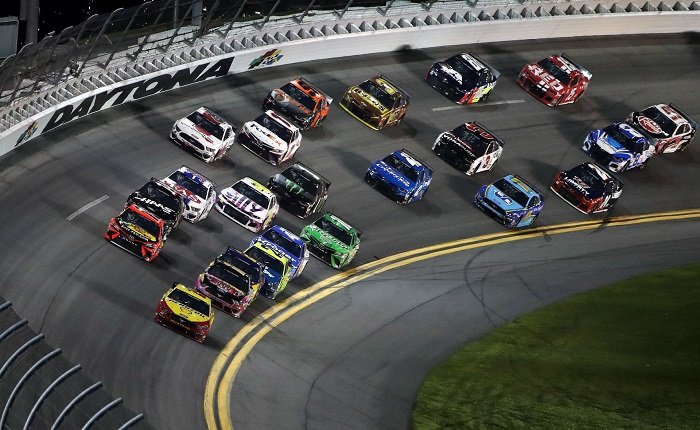NASCAR Race: Everything You Need to Know

NASCAR, the National Association for Stock Car Auto Racing, is a captivating sport that has drawn fans from all over the world with its high-speed action, thrilling finishes, and rich history. NASCAR races aren’t just about cars speeding around a track; they embody a deep-rooted culture, tradition, and community that span decades. From understanding the mechanics of the vehicles to the allure of iconic race tracks, this blog will guide you through everything you need to know about NASCAR races. We’ll explore the sport’s history, its major events, and what makes it so unique and appealing.
What is a NASCAR Race?
NASCAR race events are some of the most iconic in the world of motorsports. At their core, these races involve stock cars racing around an oval or road course track, with drivers competing to cross the finish line first. Each NASCAR race is packed with strategic overtakes, split-second decisions, and exciting moments that leave fans on the edge of their seats. But there’s more to a NASCAR race than just driving fast. Drivers and teams must carefully manage fuel consumption, tire wear, and pit stop strategies to gain a competitive advantage.
The term “NASCAR race” encompasses multiple racing series under the NASCAR umbrella. The three main series include the Cup Series, the Xfinity Series, and the Truck Series. The most prestigious NASCAR race series, the Cup Series, showcases the best drivers and teams, with events like the Daytona 500 attracting millions of fans. With such a rich history and widespread fan base, it’s no wonder that NASCAR races have become a cultural phenomenon.
History of NASCAR Racing
The history of NASCAR race events is a fascinating tale of evolution. NASCAR was founded in 1948 by Bill France Sr., who recognized the need for an organized framework for stock car racing. NASCAR race origins trace back to illegal moonshine runners during the Prohibition era, who modified their cars to outrun law enforcement. These “stock cars” eventually gave rise to competitive racing events, which became the foundation for NASCAR.
NASCAR races started small, with tracks scattered across the Southeastern United States. However, by the 1950s, the sport began to grow, with famous NASCAR races like the Daytona 500 becoming annual events. As technology improved and television broadcasts expanded, the NASCAR race scene exploded in popularity during the 1970s and 1980s. Today, NASCAR races are some of the most-watched sporting events, with drivers like Richard Petty, Dale Earnhardt, and Jeff Gordon cementing their legacies in racing history.
NASCAR Race Tracks
One of the defining aspects of any NASCAR race is the track on which it is held. NASCAR race tracks come in a variety of shapes and sizes, each offering its own unique challenges to drivers. Oval tracks, road courses, and superspeedways all host NASCAR races, requiring drivers to master different driving techniques to succeed.
The most common NASCAR race tracks are oval-shaped, with tracks like Talladega Superspeedway and the Daytona International Speedway being two of the most famous. These tracks offer high speeds and require precision driving due to their banked turns. Road courses like Sonoma Raceway and Watkins Glen present a different type of NASCAR race challenge, with sharp turns and elevation changes that demand skillful handling. Each NASCAR race track presents its own thrills, and drivers must adapt to the specific demands of each venue.
NASCAR Race Cars: Power Under the Hood
The heart of any NASCAR race lies in the cars themselves. NASCAR race cars are not your typical road vehicles; they are custom-built machines designed to go fast and endure the rigors of racing. Each NASCAR race car is engineered for speed, safety, and performance. Teams spend countless hours fine-tuning their cars to ensure that they perform at their best during a NASCAR race.
NASCAR race cars are powered by V8 engines that produce upwards of 750 horsepower, allowing them to reach speeds of over 200 mph on superspeedway tracks. However, NASCAR race cars must also be durable enough to withstand contact with other cars, wall impacts, and the heat generated during long races. The design of these cars has evolved over the years, incorporating advanced aerodynamics and safety features, such as roll cages and crumple zones, to protect drivers.
NASCAR Race Strategies: More than Just Speed
While speed is critical in any NASCAR race, strategy often plays an equally important role in determining the winner. NASCAR race teams must consider various factors, such as fuel strategy, tire management, and drafting techniques, to gain an advantage. Pit stops are a crucial part of any NASCAR race, where teams must change tires, refuel, and make adjustments in mere seconds.
One key aspect of NASCAR race strategy is drafting, where cars race closely behind one another to reduce air resistance and increase speed. This technique is particularly useful on superspeedways, where speeds exceed 200 mph. Fuel strategy is another significant element in NASCAR race planning, as teams must calculate when to pit for fuel while minimizing time lost. The best NASCAR race teams know how to balance these strategies to maximize their chances of victory.
The Role of Pit Crews in NASCAR Races
The unsung heroes of any NASCAR race are the pit crews. These highly trained teams are responsible for ensuring that their driver’s car is in optimal condition throughout the NASCAR race. Pit crews perform a variety of tasks, from changing tires and refueling to making mechanical adjustments. The speed and efficiency of a pit stop can make or break a NASCAR race, as even a few seconds lost can determine the difference between winning and losing.
During a NASCAR race, pit crews must work under extreme pressure, often making split-second decisions about tire changes, fuel levels, and car adjustments. The fastest pit stops in a NASCAR race can take as little as 12 seconds, during which time all four tires are changed, and the car is refueled. Pit crews undergo extensive training to perfect their technique and ensure that their driver has the best possible chance of success.
Famous NASCAR Race Drivers
NASCAR races have produced some of the most legendary drivers in the world of motorsports. Over the years, drivers have become household names thanks to their success on the track and their charismatic personalities. NASCAR race legends like Richard Petty, Dale Earnhardt, and Jeff Gordon have all left an indelible mark on the sport.

Richard Petty, often referred to as “The King,” won 200 NASCAR races during his illustrious career. Dale Earnhardt, known for his aggressive driving style, was a seven-time NASCAR Cup Series champion. Jeff Gordon brought a new level of professionalism and consistency to the sport, winning four championships and over 90 NASCAR races. Today, drivers like Jimmie Johnson, Kevin Harvick, and Kyle Busch continue to carry the torch, captivating fans with their skill and competitive spirit.
Iconic NASCAR Race Events
Several NASCAR race events have achieved iconic status, drawing millions of fans both in person and via television broadcasts. The Daytona 500 is perhaps the most famous NASCAR race, often referred to as “The Great American Race.” Held annually in Daytona Beach, Florida, this NASCAR race marks the start of the Cup Series season and is known for its thrilling finishes and historic moments.
Other notable NASCAR race events include the Coca-Cola 600, the longest race in the NASCAR calendar, and the Brickyard 400, held at the famous Indianapolis Motor Speedway. The Southern 500 at Darlington Raceway is another beloved NASCAR race, known for its challenging track and its rich history. These iconic NASCAR races have become cornerstones of American motorsports and are must-see events for any fan.
NASCAR Race Fan Experience
Attending a NASCAR race is an unforgettable experience. The atmosphere at a NASCAR race is electric, with fans from all over the country coming together to celebrate their love of the sport. NASCAR race fans are known for their passion and dedication, with many camping out for days before the event to secure the best spots. The tailgating culture at a NASCAR race is legendary, with fans sharing food, drinks, and stories in the parking lot before the race.
Once inside the track, the sensory experience of a NASCAR race is unlike anything else. The roar of the engines, the smell of burning rubber, and the excitement of watching cars speed by at over 200 mph make for a truly exhilarating day. Many NASCAR race events also feature concerts, driver meet-and-greets, and interactive exhibits, making it a full-day entertainment experience for fans.
How to Bet on NASCAR Races
NASCAR race betting has become increasingly popular in recent years, offering fans another way to engage with the sport. Bettors can wager on a variety of outcomes, including which driver will win the NASCAR race, which team will perform best, or even more specific bets like lap leaders and caution flags. NASCAR race odds can fluctuate throughout the season, with factors like track type, driver form, and weather conditions all affecting betting decisions.
When betting on a NASCAR race, it’s important to understand the intricacies of the sport. Factors like tire wear, fuel consumption, and pit stop strategies can all impact the outcome of a NASCAR race. Additionally, understanding a driver’s performance on different types of tracks can give bettors a significant advantage. Many sportsbooks now offer in-race betting, allowing fans to place wagers while the NASCAR race is underway.
NASCAR Race Sponsorship and Marketing
Sponsorship plays a massive role in the NASCAR race industry. From the branding on the cars to the sponsors of individual events, NASCAR races are heavily commercialized, with companies eager to get their names in front of millions of fans. NASCAR race teams rely on sponsorship dollars to fund their operations, from car development to paying drivers and crew members.
The most famous example of NASCAR race sponsorship is the Winston Cup Series, which was named after its primary sponsor, R.J. Reynolds Tobacco Company. Today, companies like Monster Energy, Coca-Cola, and Busch Beer are some of the biggest sponsors in NASCAR races. The high visibility and passionate fan base make NASCAR races an attractive platform for advertisers looking to reach a large audience.
The Future of NASCAR Racing
As NASCAR race fans look toward the future, the sport continues to evolve. Technological advancements, such as hybrid engines and data analytics, are becoming more prominent in the NASCAR race world, as teams seek every possible edge. Additionally, NASCAR has made efforts to diversify its fan base, expanding into new markets and attracting younger audiences.
NASCAR race events are also focusing more on sustainability, with initiatives to reduce the sport’s carbon footprint and promote renewable energy. Electric vehicles, once unheard of in NASCAR race circles, are now being discussed as a potential future for the sport. As the world of motorsports continues to change, NASCAR races are sure to remain at the forefront of innovation and excitement.
Conclusion
A NASCAR race is more than just a high-speed event; it is a celebration of tradition, competition, and community. From the drivers and their cars to the fans who support them, NASCAR races have cemented their place in the hearts of motorsport enthusiasts around the world. Whether you’re attending a race in person, watching it on television, or betting on your favorite driver, the thrill of a NASCAR race is unmatched. With a rich history and a promising future, NASCAR races will continue to captivate audiences for years to come.
FAQs
- What does NASCAR stand for? NASCAR stands for the National Association for Stock Car Auto Racing, an organization that governs stock car racing in the United States.
- How fast do NASCAR race cars go? NASCAR race cars can reach speeds of over 200 mph, particularly on superspeedways like Daytona and Talladega.
- What is the most famous NASCAR race? The Daytona 500 is widely considered the most famous NASCAR race, often referred to as “The Great American Race.”
- How long does a typical NASCAR race last? A typical NASCAR race can last anywhere from 2.5 to 4 hours, depending on the length of the track and the number of laps.
- What makes a NASCAR race car different from regular cars? NASCAR race cars are custom-built for racing, with powerful engines, advanced aerodynamics, and specialized safety features to handle the extreme conditions of racing at high speeds.




